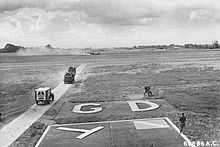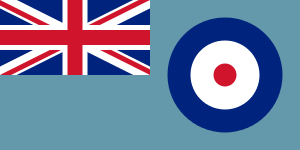RAF Great Dunmow
| RAF Great Dunmow RAF Little Easton USAAF Station AAF-164 .png)   | |||||||||||||||||||
|---|---|---|---|---|---|---|---|---|---|---|---|---|---|---|---|---|---|---|---|
|
Aerial photograph of Great Dunmow airfield 30 May 1944. | |||||||||||||||||||
| IATA: none – ICAO: none | |||||||||||||||||||
| Summary | |||||||||||||||||||
| Airport type | Military | ||||||||||||||||||
| Owner | Air Ministry | ||||||||||||||||||
| Operator |
United States Army Air Forces 1943-1944 Royal Air Force 1944-1946 British Army 1946-1948 | ||||||||||||||||||
| Location | Bishops Stortford, Essex | ||||||||||||||||||
| Built | 1942 | ||||||||||||||||||
| In use | 1943-1948 | ||||||||||||||||||
| Elevation AMSL | 322 ft / 98 m | ||||||||||||||||||
| Coordinates | 51°53′05″N 000°18′32″E / 51.88472°N 0.30889°ECoordinates: 51°53′05″N 000°18′32″E / 51.88472°N 0.30889°E | ||||||||||||||||||
| Map | |||||||||||||||||||
 RAF Great Dunmow Location in Essex | |||||||||||||||||||
| Runways | |||||||||||||||||||
| |||||||||||||||||||


Royal Air Force Station Great Dunmow or more simply RAF Great Dunmow (Also known as Little Easton) is a former Royal Air Force station in Essex, England. The airfield is located approximately 1.4 miles (2.3 km) mi west of Great Dunmow, north of the A120; about 42 miles (68 km) miles northeast of London
Opened in 1943, it was used by both the Royal Air Force and United States Army Air Forces during the war, primarily as a bomber airfield. The airfield was closed in 1948.
Today the airfield is located on private land primarily used for agriculture.
History
Great Dunmow was designed as a Class A airfield bomber airfield, built by the US Army 818th Engineer Battalion (Aviation) with specialised work by British contractors.
The airfield was built on ancient parkland belonging to Easton Lodge and some 10,000 trees were destroyed to enable its construction,[1][2] including over 200 mature oak trees. It consisted of a set of three converging runways each containing a concrete runway for takeoffs and landings, optimally placed at 60 degree angles to each other in a triangular pattern. The runways were a 6,000 ft long main runway, aligned 15/33 and two secondary 4,200 ft long secondary runways, aligned 11/29 and 04/22. An encircling perimeter track was also constructed, containing 50 loop-type hardstands.
United States Army Air Forces use
Great Dunmow airfield was opened on 1 July 1943 and was used by the United States Army Air Forces Eighth and Ninth Air Forces. It was known as USAAF Station AAF-164 for security reasons by the USAAF during the war, and by which it was referred to instead of location. It's USAAF Station Code was "GD".
USAAF Station Units assigned to RAF Great Dunmow were:[3]
- 70th Service Group[4]
- 380th Service Squadron; HHS 70th Service Group
- 20th Station Complement Squadron
- 21st Weather Squadron
- 39th Mobile Reclamation and Repair Squadron
- 40th Mobile Communications Squadron
Regular Army Station Units included:
- Quartermaster Depot Q_108
- 1577th Quartermaster Battalion
- 628th Quartermaster Battalion
- 1054th Quartermaster Company
- 1087th Signal Company
- 1176th Military Police Company
- 1769th Ordnance Supply & Maintenance Company
- 2057th Quartermaster Truck Company
- 2196th Quartermaster Truck Company
- 3215th Quartermaster Service Company
- 335th Quartermaster Depot Company
- 340th Quartermaster Depot Company
- 807th Chemical Company
- 2045th Engineer Fire Fighting Platoon
- 194th Medical Dispensary
386th Bombardment Group (Medium)

The first unit to use Great Dunmow was the American 386th Bombardment Group (Medium) which arrived from RAF Boxted on 24 September 1943. The group was assigned to the VIII Air Support Command 3d Bombardment Wing and flew Martin B-26B/C Marauders. Operational squadrons of the 322d were:
- 552d Bombardment Squadron (RG)
- 553d Bombardment Squadron (AN)
- 554th Bombardment Squadron (RU)
- 555th Bombardment Squadron (YA)
Missions of the 386th concentrated on airfields but also bombed marshalling yards and gun positions during the first months of combat.
In common with other Marauder units of the 3d Bomb Division, the 386th was transferred to Ninth Air Force 98th Bombardment Wing on 16 October 1943.
On 2 October 1944, the 386th Bomb Group moved to Beaumont-sur-Oise (A-60) Airfield, in Normandy France. On the continent, the 386th BG used the following Advanced Landing Grounds:
- A-60 Beaumont-sur-Oise France 2 October 1944
- A-92 St Trond Belgium 9 April–July 1945
After V-E Day the group returned to the United States, inactivating at Seymour Johnson AFB North Carolina on 7 August 1945.
The airfield was abandoned in 1948.
Current use
%2C_9th_Air_Force_USAAF_Memorial%2C_Easton_Lodge-Great_Dunmow%2C_Essex_-_geograph.org.uk_-_1368695.jpg)
With the end of military control in 1950[2] the grassed areas were cut for a grass meal company through the 1950s which supplied it to various farms in the region. Starting in 1960, farming operations commenced and the concrete areas were removed for aggregate in 1965/66 for use as part of the new A12 road.
Today, there is very little left except some single track agricultural roads remaining from the perimeter track and a blister hangar with a few nissen huts near Easton Lodge. The runway layout and the airfield perimeter track are easily identified in aerial photography, but no substantial amount of concrete remains. The 22 end of the secondary northeast runway does however, have a short full width of runway intact, being used for manure storage.[5] The current owners, Land Securities hope to redevelop the site and surrounding area, including the construction of around 9,000 homes.[6]
There is a small museum in Great Dunmow which holds some exhibits of the airfield and the 386th Bomb Group, along with a stained glass window memorial in Little Easton church.
See also
References
![]() This article incorporates public domain material from websites or documents of the Air Force Historical Research Agency.
This article incorporates public domain material from websites or documents of the Air Force Historical Research Agency.
Citations
- ↑ Easton Lodge Gardens: History Parks and Gardens UK, accessed 2010-12-17
- ↑ 2.0 2.1 The Gardens of Easton Lodge: After Daisy 1938 accessed 2010-12-17
- ↑ "Great Dunmow". American Air Museum in Britain. Retrieved 13 Mar 2015.
- ↑ "70th Service Group". American Air Museum in Britain. Retrieved 13 Mar 2015.
- ↑ http://maps.google.co.uk/maps?f=q&source=s_q&hl=en&geocode=&q=CM6+2BB&sll=54.489103,-2.820654&sspn=0.018496,0.055747&ie=UTF8&hq=&hnear=Dunmow+CM6+2BB,+United+Kingdom&ll=51.887991,0.318983&spn=0.000587,0.001742&t=h&z=20 Google Maps
- ↑ Strategic Land Portfolio Land Securities, accessed 2010-12-17
Bibliography
- Freeman, Roger A. (1978) Airfields of the Eighth: Then and Now. After the Battle ISBN 0-900913-09-6
- Freeman, Roger A. (1991) The Mighty Eighth: The Colour Record. Cassell & Co. ISBN 0-304-35708-1
- Freeman, Roger A. (1994) UK Airfields of the Ninth: Then and Now 1994. After the Battle ISBN 0-900913-80-0
- Freeman, Roger A. (1996) The Ninth Air Force in Colour: UK and the Continent-World War Two. After the Battle ISBN 1-85409-272-3
- Maurer, Maurer (1983). Air Force Combat Units Of World War II. Maxwell AFB, Alabama: Office of Air Force History. ISBN 0-89201-092-4.
- mighty8thaf.preller.us Great Dunmow
- USAAS-USAAC-USAAF-USAF Aircraft Serial Numbers--1908 to present
- British Automobile Association (AA), (1978), Complete Atlas of Britain, ISBN 0-86145-005-1
External links
| Wikimedia Commons has media related to RAF Great Dunmow. |
| |||||||||||||||||||||||||||||||||||||||||||||||||||||||||||||||||||||||||||||||||||
| ||||||||||||||||||||||||||||||||||||||||||||||

.svg.png)
